How many people continue their stay in the UK or apply to stay permanently?
Updated 18 June 2021
Back to ‘Immigration statistics, year ending March 2021’ content page.
This is not the latest release. View latest release.
Data relate to the year ending March 2021 and all comparisons are with the year ending March 2020, unless indicated otherwise.
On 11 March 2020, the World Health Organisation (WHO) declared the COVID-19 outbreak as a global pandemic. A range of restrictions were implemented in many parts of the world, and the first UK lockdown measures were announced on 23 March 2020. The COVID-19 pandemic has had a significant impact on the UK immigration system, both in terms of restricting migrant movements to and from the UK and the impact on operational capacity.
Year ending comparisons that follow will reflect the restrictions in place during this period of the pandemic.
This section contains data on:
- Decisions on applications for extensions of temporary stay in the UK
- Decisions on applications for settlement
- Residence documentation issued to EEA nationals and their family members
- Applications and grants of British citizenship
1. Extension of temporary stay in the UK
There were 257,637 decisions on applications to extend a person’s stay in the UK (including dependants) in the year ending March 2021, 15% fewer than in the year ending March 2020. This excludes extensions granted to individuals who were unable to leave the UK because of travel restrictions or self-isolation related to COVID-19 (see below).
Of the total extensions, 252,477 were grants, representing an overall grant rate of 98%.
Table 1: Grants by reason1,2 and refusals of extensions of temporary stay in the UK
| Year ending | Total decisions | Total grants | Work | Study | Family | Other | Total refusals |
|---|---|---|---|---|---|---|---|
| March 2020 | 301,858 | 288,861 | 114,119 | 45,250 | 109,193 | 20,299 | 12,997 |
| March 2021 | 257,637 | 252,477 | 108,410 | 33,276 | 95,718 | 15,073 | 5,160 |
| Change: latest 12 months | -44,221 | -36,384 | -5,709 | -11,974 | -13,475 | -5,226 | -7,837 |
| Percentage change | -15% | -13% | -5% | -26% | -12% | -26% | -60% |
Source: Extensions – Exe_D01
Notes:
- Includes extensions granted to NHS, frontline health and care workers whose visas are due to expire before 21 March 2021. Home Office Management Information indicates that up to the end of March 2021, there were 10,746 such extensions granted, including dependants.
- ‘Other’ excludes extensions granted to individuals who are unable to travel home because of travel restrictions or self-isolation related to COVID-19 (63,047 in the year ending March 2020, and 53,637 in the year ending March 2021). ‘Other’ includes cases where the category of grant has not been recorded.
Work was the most common route in which people extended, with 108,410 extensions in the year ending March 2021, 5% fewer than in the previous year. Indian nationals were granted the highest number of work-related extensions during the year (42% of the total).
Data for 2020 (the latest period for which analysis by previous category is available), show that almost three quarters (74%) of main applicants extending in a Work category were already previously on a Work visa, and 13% previously on a Study visa.
There were 95,718 family-related grants of extensions in the year ending March 2021, 12% fewer than in the previous year. Pakistani, Nigerian and Indian nationals are the three most common nationalities extending on this route and account for nearly two in five (37%) family-related extensions granted.
Data for 2020 on previous category show that more than two thirds (69%) of main applicants extending into a family-related category were previously on a Family visa, and a little over a quarter (26%) were in the ‘Other’ leave group (which includes cases where the previous category has not been recorded).
There were also 33,276 study-related extensions granted in the year ending March 2021, 26% fewer than in the previous year. The nationalities most likely to extend their stay for further study in the UK are broadly consistent with the nationalities granted student visas, with Chinese nationals accounting for over a quarter (28% or 9,297).
Grants in the Other category fell by 26% to 15,073 in the year ending March 2021. However, this excludes extensions granted to individuals who were unable to leave the UK because of travel restrictions or self-isolation related to COVID-19. The Other category includes 1,625 extensions granted, including dependants, in the BN(O) route.
On the 31 March 2020, as part of the response to the COVID-19 pandemic, the government announced that NHS frontline workers visas would be extended. On 29 April 2020, it was announced that other frontline health and care workers would also receive visa extensions. Healthcare professionals whose visas were due to expire between 31 March 2020 and 1 October 2020 were given a free, year-long extension. On the 20 November, it was announced that had been extended to cover visas expiring between 1 October 2020 and 31 March 2021. Up to the end of March 2021, there were 10,746 extensions granted to health workers and care workers and their dependants, under these policies.
In addition to those granted extensions under existing policies, a separate policy for those currently unable to return home due to COVID-19 was announced on 17th February 2020, which was further extended on 24th March 2020 and again on the 22nd May 2020. Up to the end of March 2021, there had been 116,684 COVID-19 related extensions granted, to individuals who were unable to travel home at the end of their current visa. Chinese and Indian nationals accounted for three quarters (75%) of these grants.
Data from the Migrant Journey report show that around 54,000 individuals were granted a COVID-19-related extension in 2020, this differs from the total number of COVID-19 extensions as some people have been granted more than one extension. The breakdown of their previous routes was:
- Visit – 53%
- Study – 20%
- Work – 13%
- Previous route unknown – 9%
- Other routes – 6%
Figure 1: Extensions of leave granted1 in the UK, by month, 2019,2020 and 2021
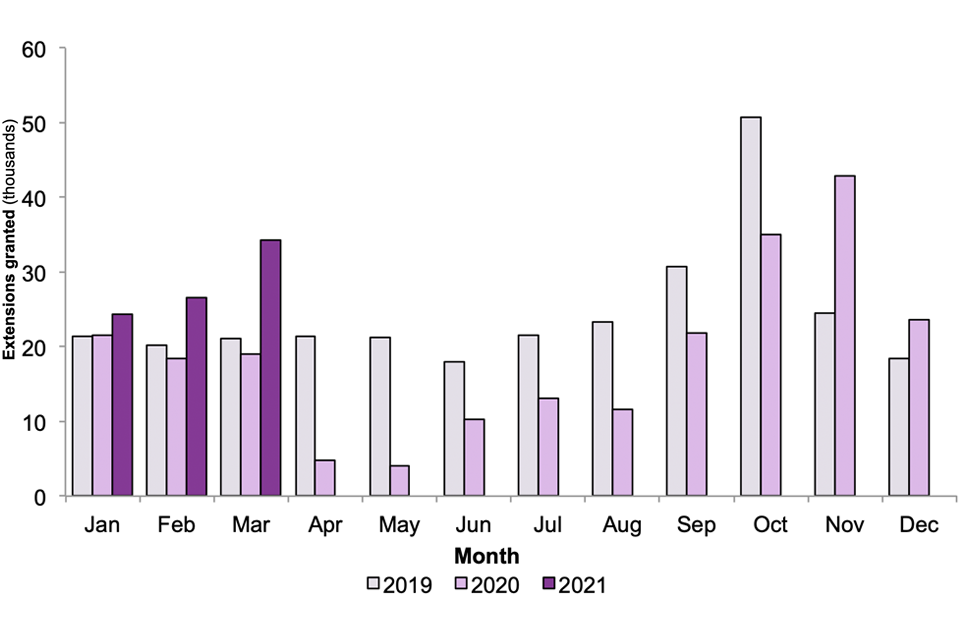
Source: Extensions – Exe_D01
Notes:
- Excludes extensions granted to individuals who were unable to leave the UK because of travel restrictions or self-isolation related to COVID-19.
Figure 1 shows that the shows that the number of grants in 2020 were similar to levels in 2019, until the onset of the COVID-19 pandemic in March 2020. From April to September 2020, grants were much lower than the same months in 2019 but began to recover from September 2020.
Grants in 2021 were higher than the same months in the previous two years. This subsequent recovery in numbers may in part be linked to the move of visa processing from an operation requiring physical presence in the office to one that can be, to a large extent, now delivered through remote working.
Data for 2020 (the latest for which extensions by previous category are available) shows that 21% of people extending their stay switched from one leave group to another (for example Study to Work), while the rest remained within their existing category of leave group.
Table 2: Grants of extensions of stay in the UK in 2020, current leave group compared with previous leave group1
| Previous leave group | Currently on Work route | Currently on Study route | Currently on Family route | Currently on Other route | Total previous reason for stay |
|---|---|---|---|---|---|
| Work | 42,567 | 723 | 1,712 | 5,665 | 50,667 |
| Study | 7,381 | 22,769 | 2,132 | 8,712 | 40,994 |
| Family | 135 | 19 | 49,209 | 2,981 | 52,344 |
| Other | 7,208 | 2,549 | 18,498 | 106,879 | 135,134 |
| Total extensions | 57,291 | 26,060 | 71,551 | 124,237 | 279,139 |
Source: Extensions – Exe_D02
Notes:
- Main applicants only
2. Settlement
There were 93,143 decisions on applications for settlement in the UK from non-EEA nationals in the year ending March 2021, 2% fewer than in the year ending March 2020. Of these, 91,346 (98%) resulted in a grant.
In the latest year there were decreases in settlement grants for:
- Family reasons (down 12% to 23,021)
- Skilled (Tier 2) work, which decreased by 16% to 18,368, and High Value (Tier 1) work decreased by 52% to 3,207
- Those previously in the UK for other reasons, primarily long residence or discretionary leave, were 29% lower at 10,072; this continued the downward trend since 2018 but numbers dropped sharply in the second and third quarters of 2020
In contrast, there was an increase in settlement granted for asylum-related reasons, up 66% to 33,375. This reflects many of those who were granted refugee status in the UK around the time of the 2015/16 ‘migration crisis’, which saw larger numbers of asylum seekers claim in the UK (and in Europe in greater numbers), now qualifying for settlement. The asylum category accounted for over a third (37%) of settlement grants in year ending March 2021.
Table 3: Grants by reason1,2,3 and refusals of settlement in the UK
| Year ending | Total decisions | Total grants | Work | Asylum | Family | Other | Refusals |
|---|---|---|---|---|---|---|---|
| March 2020 | 94,919 | 91,989 | 31,586 | 20,090 | 26,080 | 14,233 | 2,930 |
| March 2021 | 93,143 | 91,346 | 24,878 | 33,375 | 23,021 | 10,072 | 1,797 |
| Change: latest 12 months | -1,776 | -643 | -6,708 | +13,285 | -3,059 | -4,161 | -1,133 |
| Percentage change | -2% | -1% | -21% | +66% | -12% | -29% | -39% |
Source: Settlement table se_02_q
Notes:
- In addition to the impacts of COVID-19, the number of decisions in a given year can be affected by changes in casework resource allocation. Such fluctuations can be examined in more detail in the quarterly data that are available in the published Settlement tables.
- Trends in numbers applying for settlement will in part reflect policies and patterns of migration some years earlier.
- ‘Other’ includes grants on the basis of Long Residence and grants on a discretionary basis. Also includes a small number of cases where the category of grant has not been recorded.
Figure 2: Grants of settlement in the UK, by reason1, years ending March 2012 to March 2021
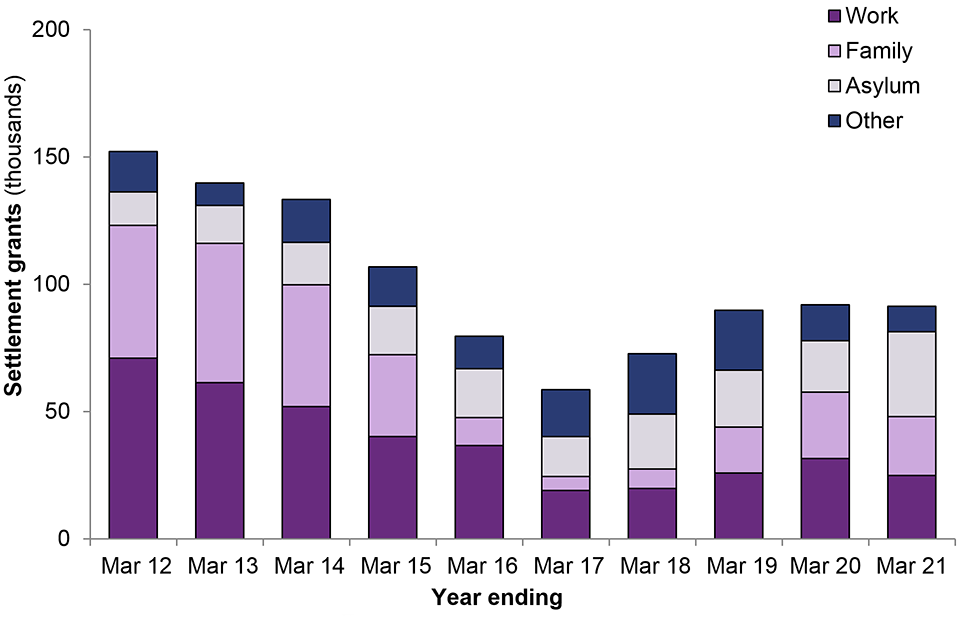
Source: Settlement table se_02_q
Notes:
- Reason relates to type of leave held immediately prior to being granted settlement.
Figure 2 shows the number of settlement grants has decreased from 152,000 in the year ending March 2012 to 91,000 in the year ending March 2021, although the lowest levels were seen in the year ending March 2017 with 59,000 grants. Since the year ending March 2012, grants for work reasons have decreased, from 71,000 to 25,000. Grants for family reasons also fell across this period, from 52,000 to 23,000. In contrast, grants for reasons of asylum increased from 13,000 to 33,000. Grants for ‘other’ reasons (not relating to work, family or asylum) fell from 16,000 to 10,000. Trends in numbers applying for settlement will in part reflect policies and patterns of migration some years earlier.
Figure 3: Grants of settlement in the UK, by month, 2019, 2020 and 2021
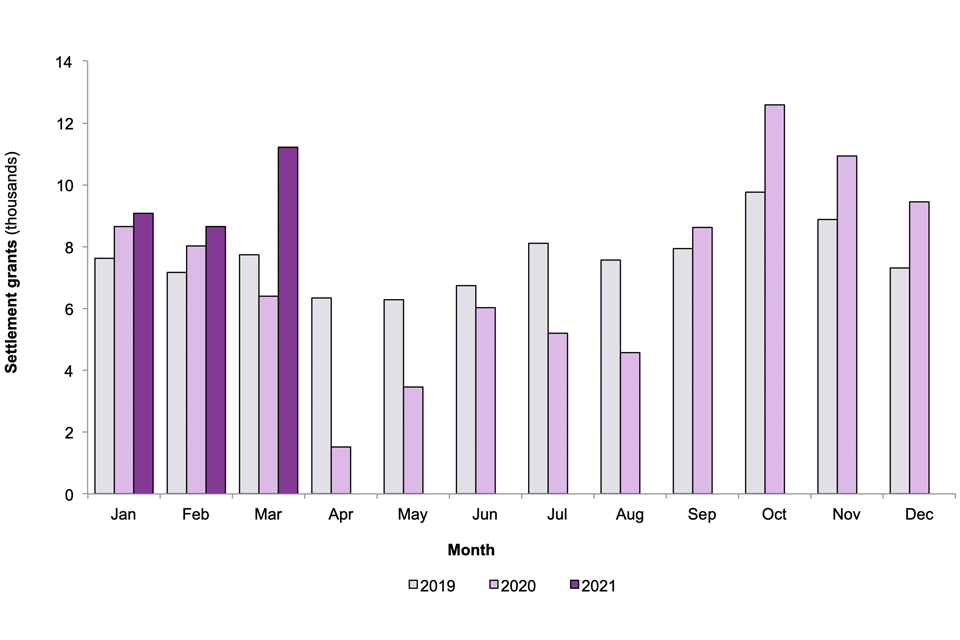
Source: Settlement table se_02_q
Figure 3 shows that the number of settlement grants fell significantly at the start of the COVID-19 pandemic, and the beginning of restrictions in the UK. From April 2020, UK Visa and Citizenship Application Centres (UKVCAS) temporary closed, there was a temporary pause of postal routes, and the processing operation moved from one focused on physical presence in the office to one that can be, to a large extent, delivered through remote working.
From May 2020, the number of grants generally started to recover again as caseworkers became able to fully operate remotely whilst a minimal office presence processes physical documents within ‘Covid secure’ parameters for the accommodation.
From September 2020, grants of settlement were higher compared with the same month the previous year. Grants in the period January to March 2021 were 25% higher than in the same period in 2020 and 29% higher than in the same period in 2019.
3. EEA nationals and their family members
Under European law, EEA nationals and their dependants did not need to obtain documentation confirming their right of residence in the UK but could apply for registration certificates and documents certifying permanent residence in the UK. Their non-EEA family members could apply for residence and permanent residence cards. These acted as confirmation of their right to stay in the UK.
Some current residence documents will no longer be valid after 30 June 2021. Applications received before 1 January 2021 are still being processed. More information is available on the relevant visas and immigration pages on GOV.UK.
Since 30 March 2019, EU and EEA nationals resident in the UK, along with their non-EEA family members, can apply to the EU Settlement Scheme to continue living in the UK.
The Home Office publishes monthly updates and quarterly experimental statistics on the EU Settlement Scheme (EUSS), available on GOV.UK. The latest quarterly statistics report was published on 27 May 2021 (for the period up to 31 March 2021) and the most recent monthly summary (to April 2021) was published on 13 May 2021.
The latest data show that 5.42 million applications to the EU Settlement Scheme had been received up to 31 April 2021.
3.1 Documents issued
In the year ending March 2021, there were a total of 36,138 decisions in applications for EEA residence documents, 64% fewer than the previous 12 months. This included 14,343 registration certificates and registration cards issued, and 7,627 documents certifying permanent residence and permanent residence cards issued.
Table 4: Decisions in applications for EEA residence documents1,2
| Year ending | Total decisions | Of total decisions, registration certificates and residence cards - issued | Of total decisions, documents certifying permanent residence and permanent residence cards - issued |
|---|---|---|---|
| March 2020 | 101,153 | 44,825 | 28,314 |
| March 2021 | 36,138 | 14,343 | 7,627 |
| Change: latest 12 months | -65,015 | -30,482 | -20,687 |
| Percentage change | -64% | -68% | -73% |
Source: Table EEA_01
Notes:
- Registration certificates (EEA nationals) and residence cards (non-EEA family members) reflect documents issued to confirm a treaty right as an EEA national or confirm status as a family member of an EEA national; see User Guide Glossary of Terms.
- Documents certifying permanent residence (EEA nationals) and permanent residence cards (non-EEA family members) reflect documents issued to EEA and non-EEA nationals for an indefinite period after 5 years living in the UK; see User Guide Glossary of Terms.
4. Citizenship
4.1 Applications for British citizenship
There were 176,910 applications for British citizenship in the year ending March 2021, 7% more than in the year ending March 2020.
Applications for citizenship by EU nationals rose by 45% compared to the previous year, to 63,872. Figure 4 shows that the number of Non-EU applications has decreased since 2012, whilst EU applications have increased. EU nationals now account for more than a third (36%) of all citizenship applications compared with 12% in 2016. Increases in citizenship applications from EU nationals since 2016 are likely to reflect more people seeking to confirm their status in the UK following the EU referendum and the UK’s exit from the EU.
Applications made by non-EU nationals fell by 7% in the year ending March 2021 to 113,038 although the trend in non-EU citizenship applications has been broadly stable since 2014.
There were 50,279 applications for British citizenship in the first quarter of 2021, 14% higher than in the same quarter in 2020. The increase in the first quarter of 2021 was driven by applications from EU nationals (17,252) which were 37% higher than in the first quarter of 2020 (12,609).
Figure 4: Number of applications for British citizenship from EU and non-EU nationals1,2, years ending March 2012 to March 2021
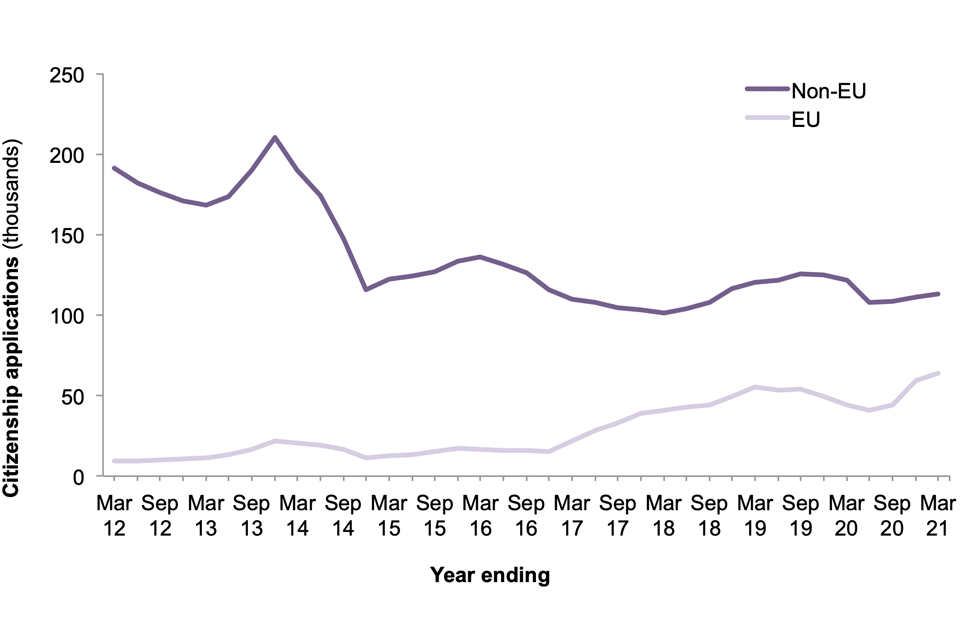
Source: Citizenship detailed dataset Cit_D01
Notes:
- Series are based on current EU membership; for example, Croatia (who joined the EU in 2013) are included in the EU total for the entire time series.
- The increase in applications made in 2013 may have reflected people anticipating the rule change to the English language element of the ‘Life in the UK’ test as of 28 October 2013. See the Policy and Legislative Changes Timeline for details.
4.2 Grants of British citizenship
There were 125,691 grants of British citizenship in YE March 2021, 23% fewer than the previous year. This fall was due in part to the COVID-19 pandemic response and comes after a period of relative stability since 2014. Prior to this there was a peak of 208,095 in 2013, which came before a change to the English language element of the ‘Life in the UK’ test.
There were 42,217 grants of British citizenship to former EU citizens in the year ending March 2021, 3,813 or 8% fewer than the previous year. Italian nationals were the top EU nationality granted citizenship in the latest year (6,271), followed by Romanian (6,025) and Polish (5,464) nationals.
There were 83,474 grants of British citizenship to former non-EU citizens in the year ending March 2021, 34,120 or 29% fewer than the previous year. The top non-EU nationalities granted British citizenship were Pakistani (9,995), Indian (9,506) and Nigerian (7,063) nationals. These three nationalities accounted for a just under a third (32%) of all grants to non-EU nationals.
Of the grants of British citizenship in the last year, more than half (56%) were to those who qualified for naturalisation after five or more years’ residence in the UK. Grants of naturalisation by residence fell by 20% to 45,290 for former non-EU citizens, but only by 3% to 25,474 in former EU citizens. Total grants of citizenship following marriage to a British citizen fell by 28% to 23,253 including a fall of 34% to 16,551 for former non-EU citizens. The number of grants of citizenship for registration of children fell by 40% to 16,250 for former non-EU citizens, and 13% to 8,918 for former EU citizens.
Table 5: Grants by reason1 and refusals of citizenship applications
| Year ending | Total decisions | Total grants | Residence | Marriage | Children | Other | Refusals and withdrawals |
|---|---|---|---|---|---|---|---|
| March 2020 | 170,319 | 163,624 | 82,818 | 32,446 | 37,496 | 10,864 | 6,695 |
| March 2021 | 130,947 | 125,691 | 70,764 | 23,253 | 25,168 | 6,506 | 5,256 |
| Change: latest 12 months | -39,372 | -37,933 | -12,054 | -9,193 | -12,328 | -4,358 | -1,439 |
| Percentage change | -23% | -23% | -15% | -28% | -33% | -40% | -21% |
Source: Citizenship detailed datasets – Cit_D02
Notes:
- ‘Other’ includes Entitlement and Discretionary registration as an adult, Entitlement and Discretionary registration on other grounds, and registration under Section 5 of the British Nationality Act 1981. See the user guide for more details.
The Home Office published a report on 28 May 2020, which provided a statistical overview of COVID-19 impacts on the immigration system through to the end of April 2020. Since that time, there have been further changes in the period to the end of March 2021.
As shown in Figure 5, the number of citizenship grants fell significantly in April 2020 to 2,291, 81% fewer than April 2019. The number of grants started to recover in the following months before further large decreases in January (down 31% compared to the same month a year earlier) and February 2021 (down 22%). The number of citizenship grants in March 2021 was 36% higher than the same month a year earlier, the first month this was the case since the pandemic began.
Figure 5: Grants of British citizenship, by month, 2019, 2020 and 2021
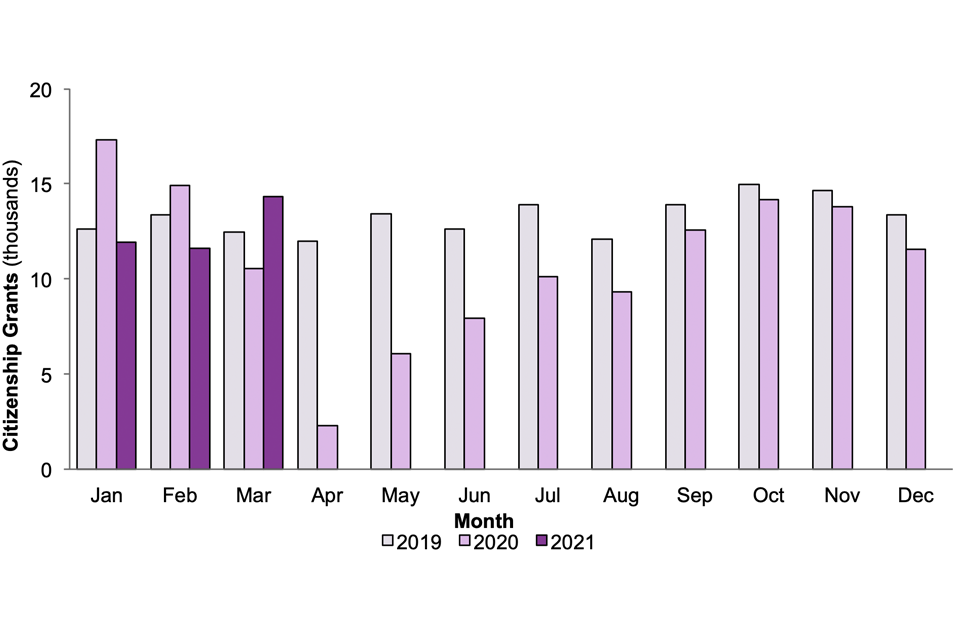
Source: Citizenship detailed datasets Cit_D02 and underlying datasets
5. About these statistics
The statistics in this section refer to individuals who have leave to remain in the UK who wish to extend, or make permanent, their right to remain in the UK.
Before 2021, due to European Union (EU) freedom of movement principles, the majority of UK immigration control related to non-European Economic Area (EEA) nationals. From 2021, unless otherwise stated, data in this release relate to both EEA and non-EEA nationals.
Data in this section should be viewed in the context of wider policy and legislative changes, which can impact the number of applications and decisions. They should also consider the availability and allocation of resources within the Home Office, which can affect the number of decisions made in a given period. For example, fewer citizenship decisions were made in 2015 when UK Visas and Immigration (UKVI) resources were used to assist HM Passport Office.
The statistics should not be used to make inferences about the size of the non-British population in the UK. The data do not show whether, or for how long, an individual remains in the UK once their right to remain has been extended or made permanent. Statistics on resident foreign populations in the UK are published by the Office for National Statistics (ONS).
5.1 Extension of temporary stay in the UK
Extensions of temporary stay in the UK relate to individuals inside the UK extending or changing the status of their right to stay in the UK. An individual is required to apply for an extension or change in status before their existing permission to enter or stay in the UK expires.
The statistics in this section show the number of grants and refusals in a given year on applications for extension of temporary stay in the UK. One individual may have made multiple applications for an extension, so may account for multiple decisions in a given period. Data in this section include dependants and take account of the outcomes of reconsiderations and appeals.
The statistics do not show the number of people applying to extend their temporary stay in the UK, nor do they show how long an individual stayed in the UK following their extension.
The statistics in the previous immigration category of students granted an extension were estimated for 2013, 2014, 2015, 2016 and 2018. Data for 2017 are unaffected.
Further information on the statistics in this section can be found in the extension section of the user guide.
5.2 Settlement
Settlement can be granted to individuals – subject to immigration control – to allow them to work, study and travel into and out of the UK without restriction. To be granted settlement, individuals generally must have lived in the UK for a certain length of time in a qualifying category. Those granted settlement can access state benefits and register their UK-born children as British citizens. It does not entitle the individual to a British passport (which requires British citizenship) or to vote in a general election (which requires British, Commonwealth or Irish Republic citizenship).
The statistics in this section show the number of grants and refusals in a given year on applications for settlement in the UK. They take account of the outcomes of reconsiderations and appeals.
The data on settlement refusals relate to cases where settlement was refused and no other form of leave was granted. Cases where settlement was refused but an extension was granted instead (for example where an individual has not met the qualifying period for settlement) will not be included in the refusal figure.
Individuals who leave the UK for more than 2 years may have their settlement status revoked, except in exceptional circumstances. The statistics do not differentiate between those granted settlement for the first time and those granted settlement multiple times.
5.3 EEA nationals and their family members
Some current residence documents will no longer be valid after 30 June 2021. Applications received before 1 January 2021 are still being processed. The EU Settlement Scheme enables EU, other EEA and Swiss citizens, and their family members, to obtain a UK immigration status. Further information about the EU Settlement Scheme can be found at Apply to the EU Settlement Scheme (settled and pre-settled status).
The scheme is a simple digital system which allows EU, EEA and Swiss citizens who are resident in the UK to obtain, free of charge, settled status or pre-settled status in the UK. Find out more about what settled and pre-settled status means.
EEA and Swiss nationals have freedom of movement throughout the EEA. Non-EEA nationals who are dependants of EEA national residents in the UK can share their residence if they satisfy certain conditions. See the user guide for details.
The statistics in this section show the number of registration certificates and registration cards issued, and the number of documents certifying permanent residence and permanent residence cards issued before the end of the Transition period on 31 December 2020.
After 12 November 2015, a person applying for citizenship who is claiming to have permanent residence as an EEA national, or the family member of an EEA national, has been required to provide a permanent residence card or a document certifying permanent residence as evidence that they meet the requirement to be free of immigration time restrictions. These rule changes, along with EEA nationals’ response to perceived uncertainty following the 2016 EU referendum, are likely to have contributed to the steep increase in demand for EEA residence documentation during 2016 and 2017.
Variations in numbers of decisions can be affected by changes in resources and the mix of cases, as well as policy changes and application levels in earlier periods.
More information about applying for residence documentation and how the status of EU citizens in the UK will be secured now the UK has left the EU is available on GOV.UK.
Figures on applications received and cases currently outstanding in the European casework route (along with other information such as percentage processed within service standards) can be found in ‘In-country migration data’ on GOV.UK.
5.4 Citizenship
British citizens can live and work in the UK free of any immigration controls. They can apply for a British passport, register to vote in all forms of election and referenda, and share in all the other rights and responsibilities of their status.
Dual citizenship (also known as dual nationality) is allowed in the UK. This means people can be a British citizen and a citizen of other countries.
If someone is not already a British citizen based on where and when they were born, or their parents’ circumstances, they can apply to become one.
The statistics in this section show the number of applications for British citizenship. Data on the number of grants of citizenship are available in the associated data tables.
In May 2021, the Home Office published the ‘Migrant journey: 2020 report’, which explores changes in non-EEA migrants’ visa and leave status as they journey through the UK’s immigration system.
6. Data tables
Data referred to here can be found in the following tables:
- Extensions summary tables
- Detailed extensions datasets
- Settlement tables
- Citizenship summary tables
- Detailed Citizenship datasets
- European Economic Area (EEA) tables
We welcome your feedback
If you have any comments or suggestions for the development of this report, please provide feedback by emailing MigrationStatsEnquiries@homeoffice.gov.uk. Please include the words ‘PUBLICATION FEEDBACK’ in the subject of your email.
We’re always looking to improve the accessibility of our documents. If you find any problems or have any feedback relating to accessibility, please email us.
See section 7 of the ‘About this release’ section for more details.
